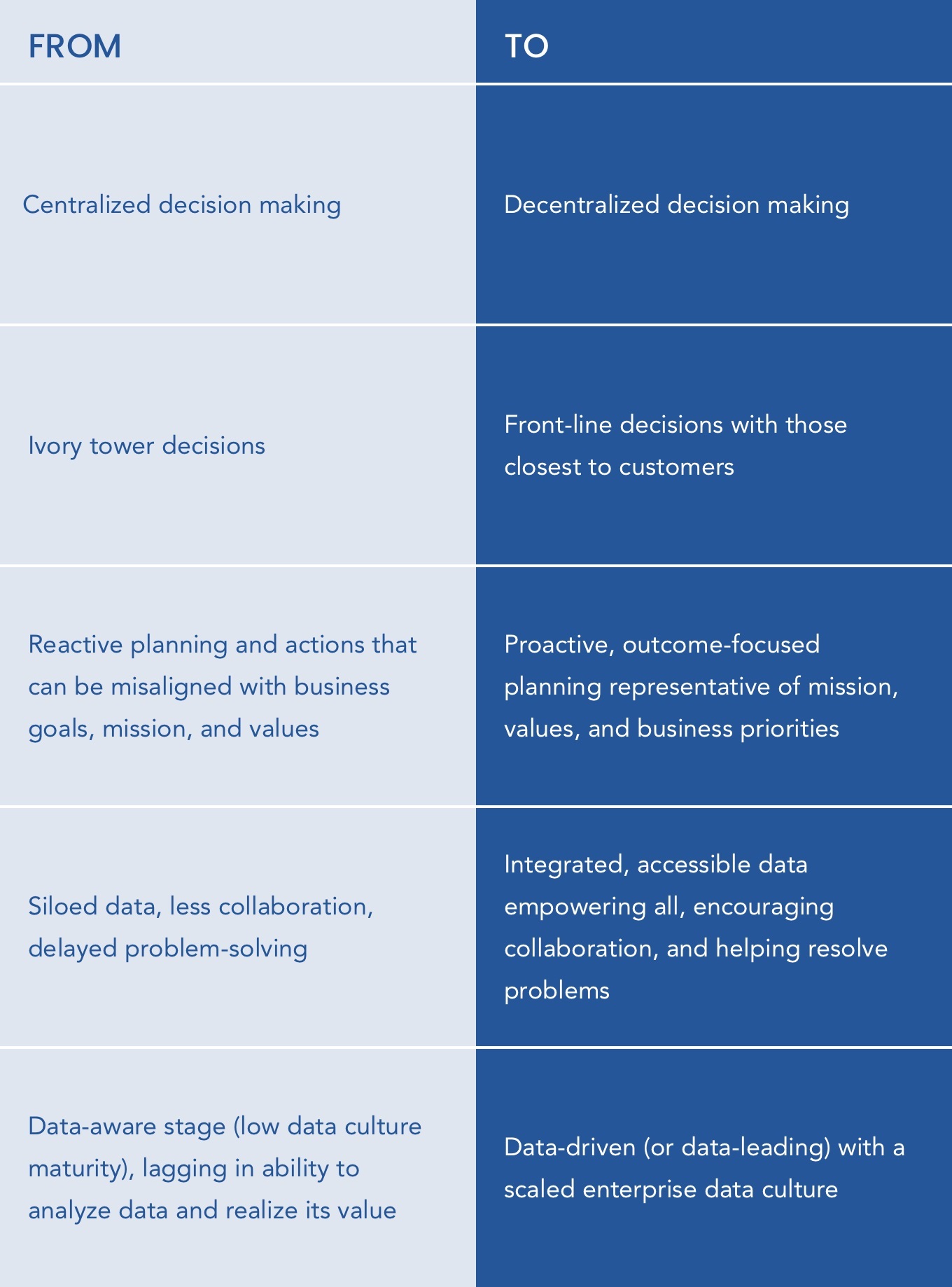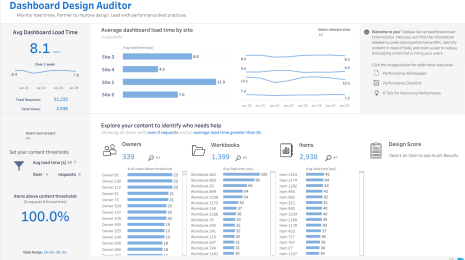How to harness a new wave of data-driven decision making
Editor's note: This article originally appeared in Forbes, by Jennifer Day, Vice President, Customer Strategy and Programs, Tableau
Many businesses recently made strategic moves to build or enhance their data cultures, enabling people to make better, faster decisions as they faced unprecedented challenges. This increased pace of change forced urgent prioritization and a higher rate of decision making as data became critical to business survival during the pandemic.
In hindsight, business leaders experienced disruptions to operations like customer service, sales, finance, the supply chain, and more. And data-driven decision making, defined as taking action and influencing innovation with data and analytics, played a critical role in business response to the pandemic. Moving ahead, data-driven decisions will outweigh gut decision making as normal operations resume. “A positive that came out of this time is that everyone has renewed appreciation for what data can do for their organization,” explained Jeremy Blaney, Director, Customer Solutions at Tableau. “Data-driven decisions went from being a priority goal to absolutely necessary in order to survive the unplanned and significant changes to the business environment.”
Those businesses that made strategic moves, even before the pandemic, maximizing technology investments, supporting broader data skills (or what some call analytics proficiency), and developing infrastructure that enables wide-scale decision making have seen greater value from data and analytics. We expect to see more of these instances as we look ahead. And data will increasingly intersect the people, technologies, and processes that organizations rely on for strategic success to improve widespread behaviors and beliefs around its use.
The shift: Strategic influences of a Data Culture
With the rapid pace of global change that further escalated due to the pandemic’s impact, we’re seeing an important and strategic shift—both in how businesses operate and how decisions are made by everyone.

“Companies went into 2020 with a plan. As COVID-19 spread and disrupted all aspects of life, companies had to create new plans, making multiple pivots as the year continued and the environment changed,” explained Vik Ekambaram, Director, Innovation Consulting at Tableau. A rapid pace of change required that decisions happen from the bottom up—not top-down. “We followed 20th-century processes (e.g., annual planning, quarterly reviews) for decision making, and that won’t cut it in the 21st-century, ever-changing landscape,” added Ekambaram.
3 ways to easily integrate data in daily workflows
With recognition of these strategic shifts, let’s look closer at some fundamental ways organizations can integrate data in workflows and decisions happening throughout teams and staff levels. We’ll discuss how to take these steps and what is required.
1. Data curiosity and regular use by all
This looks like people coming prepared to meetings with data—not using a static printout—and relying on real-time connections to underlying data sources so they can answer questions as quickly as they’re asked. It also means folding it into their daily work and discussions with their team, manager, and other business groups. Before, data was more of an afterthought, explored after discussions or meetings happened. It took time to reconnect on data reporting to evaluate key changes and insights, solve problems, and act. And sometimes it was too late: The data was stale, equating to lost time, money, productivity, and effectiveness.
With data-driven organizations, employees possess a data-oriented mindset and confidence in applying analytical insights. They have access to trusted, live data sources and use data often as they experiment, test, innovate, and learn.

2. Eliminate business and data silos to increase collaboration
Data in isolation isn’t useful. But we often see mountains of data sitting on a desktop, in spreadsheets, or in the hands of inundated analysts or data scientists who are disconnected from business use cases. It’s better to solve critical problems by breaking down silos to gain maximum value from your organizational data.

3. Leader-modeled data behaviors that translate to the front lines
Having appointed stakeholders who drive value with data steers organizations to develop a culture of decision making at every level—not only leadership.
On some occasions, leaders may need to intervene and shut down a project because it’s too resource-intensive or to reassign investments. However, those choices are easier when you bring others along, invite and listen to feedback, and consistently communicate with data and show its value.

How to integrate data in your lines of business
After seeing and experiencing—on our own and through customers—the good that comes from data, we recognize some businesses need plans for taking data-driven decision making into key functions. Here are some tips we have as you look ahead:
- Finance: Finance moves fast. That’s why it’s necessary to move beyond spreadsheets to a flexible business intelligence solution as sophisticated as your forecasting, audit, risk, and pricing data. With powerful analytics delivered on a governed platform that IT can trust, bring finance data together and report it in a way that fuels business strategy and decisions. See some examples of finance analytics in action.
- Sales: Are you trying to forecast quotas and see if you attained them? Do you have a clear understanding of your pipeline or if it’s at risk? Data and analytics can help sales transcend report creation and overcome silos by providing clear, actionable insights that illuminate what’s working or not, where the strongest leads are, and where to prioritize and scale resources for success. Explore and understand the value of sales analytics.
- Supply Chain: Supply chains were seriously disrupted in the last year. Businesses across different industries had to optimize lean inventory, pivot to put high-demand products in consumers’ hands, and analyze impacts of the current environment on their supply chain to avoid risk. Data-driven insights were mandatory to make plans and modify them on the fly. Hear how Jaguar Land Rover and supply chain solutions provider Ahlers accelerated their data transformations in the face of disruption, uncertainty, and the impact on their supply chains. Plus, see how a data and analytics solution can enhance supply chain efforts.
- Marketing: Is your organization evolving its marketing data analytics to stay on pace with or ahead of the rate of change? Marketing teams are constantly evolving and being asked for creative, smart, thoughtful ideas that engage customers and prospects. Businesses that bring marketing data together gain valuable insights into areas such as digital media spend, website performance, and customer journeys. See how analytics transforms your marketing.
Elevate your business decisions now
The possibility of becoming data-leading can turn to reality if you start following these three ways of folding data into daily workflows and the business. On top of that, bringing analytics into key business functions is valuable and needed to support your mission, values, and priority performance measures.
Hear from organizations that lead with a Data Culture and discover some ways that Tableau can support your journey by visiting Tableau’s “Build a Data Culture” resource hub. When you’re ready to evolve your data maturity, the Tableau Blueprint Assessment can help you measure where you are, plan for the future with customized, actionable recommendations, and build a data-driven organization.
相关故事
Subscribe to our blog
在您的收件箱中获取最新的 Tableau 更新。








